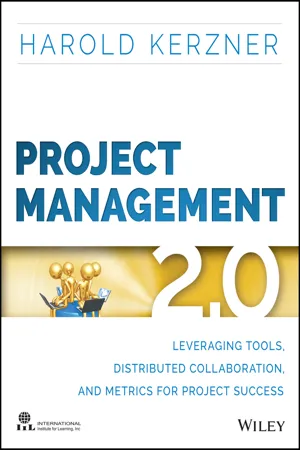
Project Management 2.0
Leveraging Tools, Distributed Collaboration, and Metrics for Project Success
- English
- ePUB (mobile friendly)
- Available on iOS & Android
Project Management 2.0
Leveraging Tools, Distributed Collaboration, and Metrics for Project Success
About this book
PROJECT MANAGEMENT 2.0
MASTER PROJECT MANAGEMENT FOR A VIRTUAL WORLD
In this full color guide, Project Management expert Harold Kerzner provides much needed guidance on today's changing project management mechanics, especially the growing importance of value metrics and key performance indicators. In Project Management 2.0, Kerzner explains how PM 2.0 offers better outcomes with a focus on new tools, better governance, and improved collaboration. Kerzner also compares various methodologies and examines how PM 2.0 facilitates problem solving and decision making. You'll find essential background on PM 2.0, as well as a detailed examination of web-based project management tools and how to use them.
- Improve project governance and collaboration with stakeholders
- Achieve more meaningful information reporting with KPIs, metrics, and dashboards
- Discover easier ways for teams to work together from different locations
- Gain an understanding of the project manager's role in strategic planning and portfolio management
- Implement problem-solving and decision-making processes
- Understand how to implement effective methodologies
Project Management 2.0 explains PM 2.0 tools and techniques that managers, project team members, engineers, and consultants can start using now for improved project outcomes.
Frequently asked questions
- Essential is ideal for learners and professionals who enjoy exploring a wide range of subjects. Access the Essential Library with 800,000+ trusted titles and best-sellers across business, personal growth, and the humanities. Includes unlimited reading time and Standard Read Aloud voice.
- Complete: Perfect for advanced learners and researchers needing full, unrestricted access. Unlock 1.4M+ books across hundreds of subjects, including academic and specialized titles. The Complete Plan also includes advanced features like Premium Read Aloud and Research Assistant.
Please note we cannot support devices running on iOS 13 and Android 7 or earlier. Learn more about using the app.
Information
CHAPTER 1
PROJECT MANAGEMENT 2.0

1.0 INTRODUCTION: CHANGING TIMES
1.1 CHARACTERISTICS OF PM 1.0
- Projects are identified, evaluated, and approved without any involvement by project managers.
- Project planning is done by a centralized planning group, which may or may not include the project manager.
- Even though the planners may not fully understand the complexities of the project, the assumption is made that the planners can develop the correct baselines and plans which would remain unchanged for the duration of the project.
- Team members are assigned to the project and expected to perform according to a plan in which they had virtually no input.
- Baselines are established and often approved by senior management without any input from the project team, and again the assumption is made that these baselines will not change over the duration of the project.
- Any deviations from the baselines are seen as variances that need to be corrected to maintain the original plan.
- Project success is defined as meeting the planned baselines; resources and tasks may be continuously realigned to maintain the baselines.
- If scope changes are necessary, there is a tendency to approve only those scope changes where the existing baselines will not change very much.
1.2 OTHER CRITICAL ISSUES WITH PM 1.0
- Believing that one project management methodology can be applied to every project
- Taking for granted that the constraints and assumptions that are in the business case/charter are correct and need not be tracked
- Trusting that the planning of others, such as a planning department, is always correct and need not be challenged
- Lacking ownership of plans we did not participate in, resulting in lack of commitment to the project
- Working with a structured project plan that does not allow for the creativity of team members
- Not having all necessary information available to the project team
- Working with sponsors and governance committees that do not understand their roles and responsibilities
- Trusting that all of the decisions made by the sponsors or governance committees are the correct decisions
- Believing that implementing project management by executive decree will make it work
- Having no project management culture in the firm
- Believing that a changeover to a project management culture can happen overnight
- Having project management recognized as a part-time addition to one's primary job rather than seen as a career path opportunity
- Not understanding the need for project health checks or how to perform a health check
- Having limited tools to support project management activities
- Having too many projects a...
Table of contents
- Cover
- Title Page
- Copyright
- DEDICATION
- PREFACE
- ACKNOWLEDGMENTS
- FOREWORD
- CHAPTER 1: PROJECT MANAGEMENT 2.0
- CHAPTER 2: A PEEK INTO THE FUTURE OF PROJECT MANAGEMENT
- CHAPTER 3: UNDERSTANDING SUCCESS AND FAILURE
- CHAPTER 4: VALUE-DRIVEN PROJECT MANAGEMENT
- CHAPTER 5: GROWING IMPORTANCE OF METRICS WITH PM 2.0
- CHAPTER 6: PROJECT MANAGEMENT METHODOLOGIES: 1.0 VERSUS 2.0
- CHAPTER 7: PROJECT GOVERNANCE
- CHAPTER 8: ROLE OF PROJECT MANAGER IN STRATEGIC PLANNING AND PORTFOLIO MANAGEMENT
- CHAPTER 9: R&D PROJECT MANAGEMENT
- CHAPTER 10: PROBLEM SOLVING AND DECISION MAKING1
- CHAPTER 11: NEED FOR PROJECT MANAGEMENT
- CHAPTER 12: USING THE PMO TO SPEARHEAD PM 2.0
- INDEX
- End User License Agreement